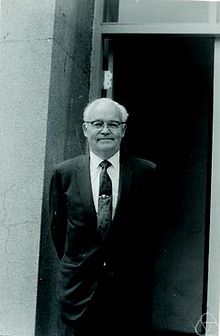|
Magnus Hestenes
Magnus Rudolph Hestenes (February 13, 1906 – May 31, 1991) was an American mathematician best known for his contributions to calculus of variations and optimal control.[1] As a pioneer in computer science, he devised the conjugate gradient method, published jointly with Eduard Stiefel.[2][3] BiographyBorn in Bricelyn, Minnesota, Hestenes graduated with a B.S. in 1927 from St. Olaf College and with an M.A. in 1928 from the University of Wisconsin–Madison.[4] He earned his Ph.D. at the University of Chicago in 1932 under Gilbert Bliss. His dissertation was titled "Sufficient Conditions for the General Problem of Mayer with Variable End-Points." After teaching as an associate professor at Chicago, in 1947 he moved to a professorship at UCLA. He continued there until his retirement in 1973, and during that time he served as department chair from 1950 to 1958. While a professor, Hestenes supervised the thesis research of 34 students, among them Glen Culler, Richard Tapia and Jesse Wilkins, Jr. Hestenes received the Guggenheim (1954) and Fulbright awards, was a vice president of the American Mathematical Society, and was an invited speaker at the 1954 International Congress of Mathematicians in Amsterdam.[5] He is the father of mathematician and physicist David Hestenes. He died on May 31, 1991, in Los Angeles, California. Selected publications
References
External links
|
||||||||||||||||||||||||||||
